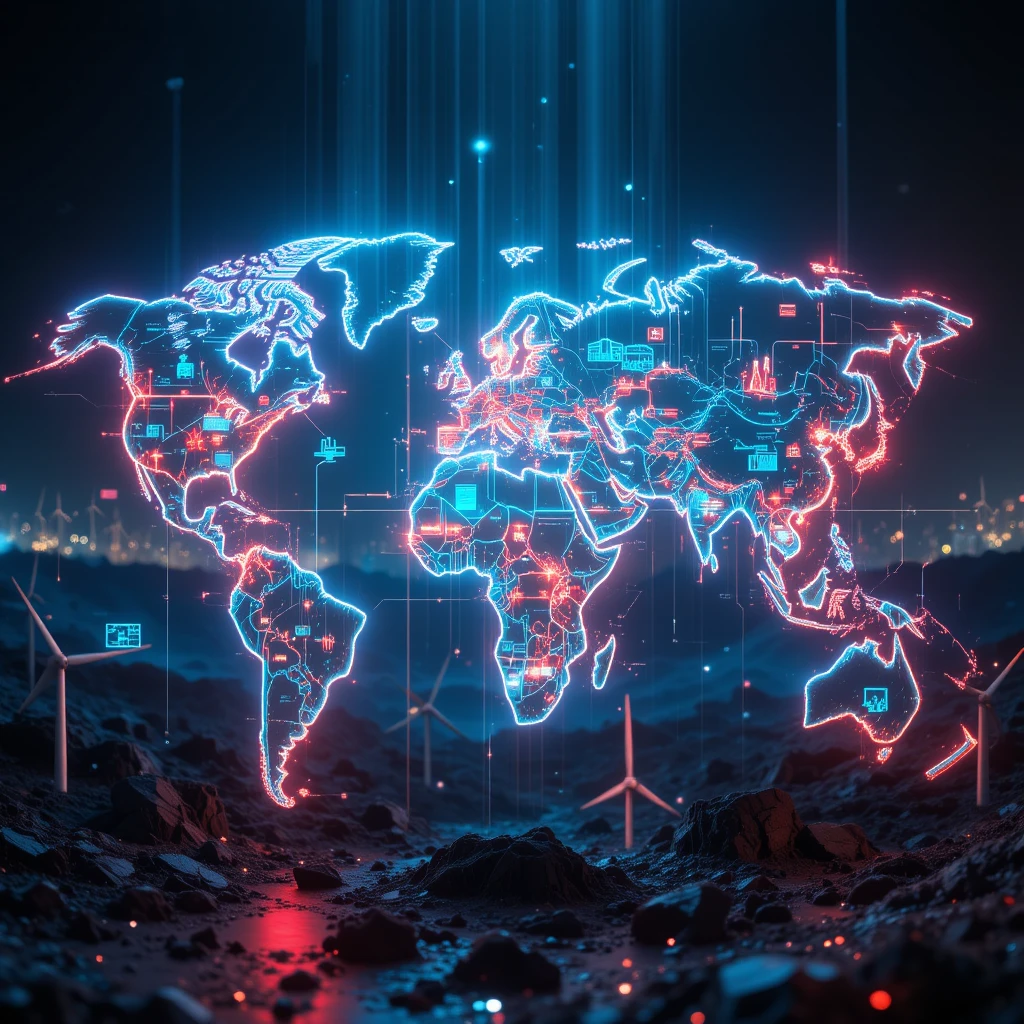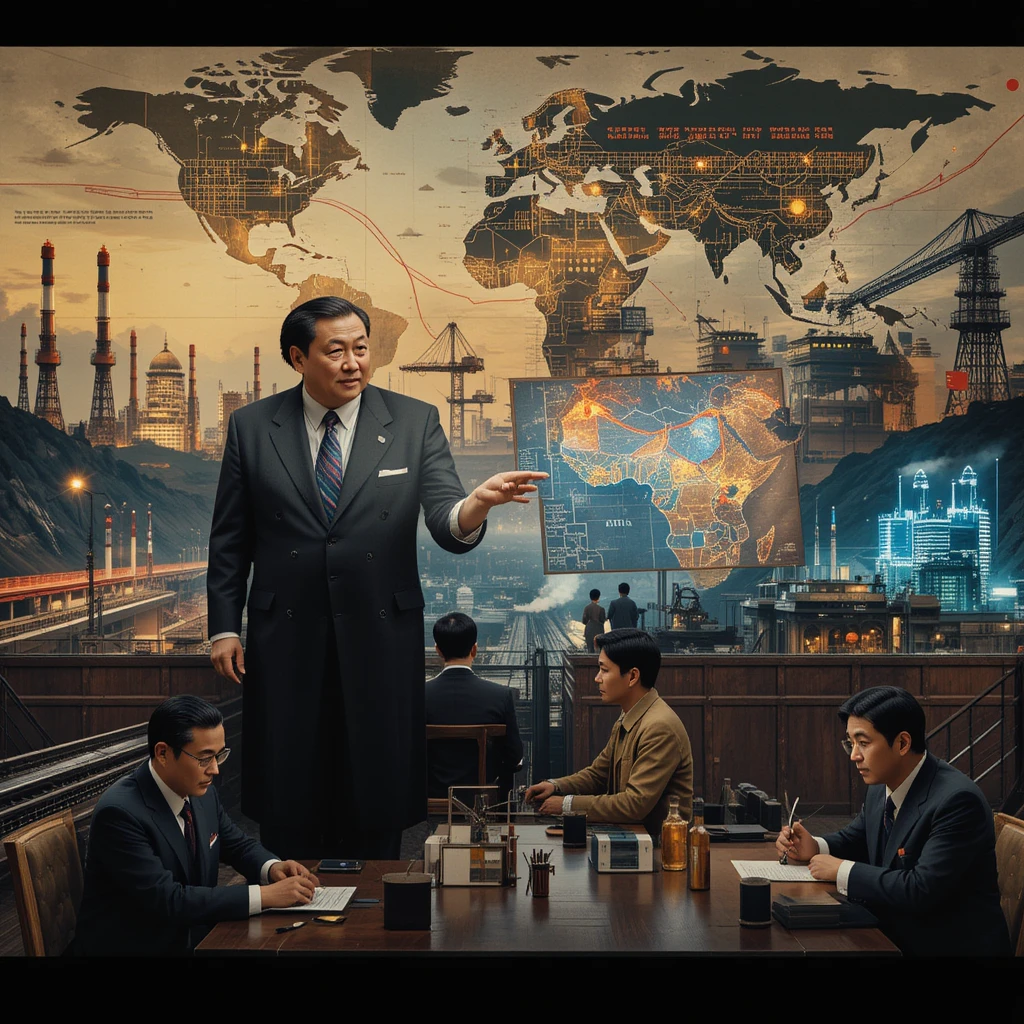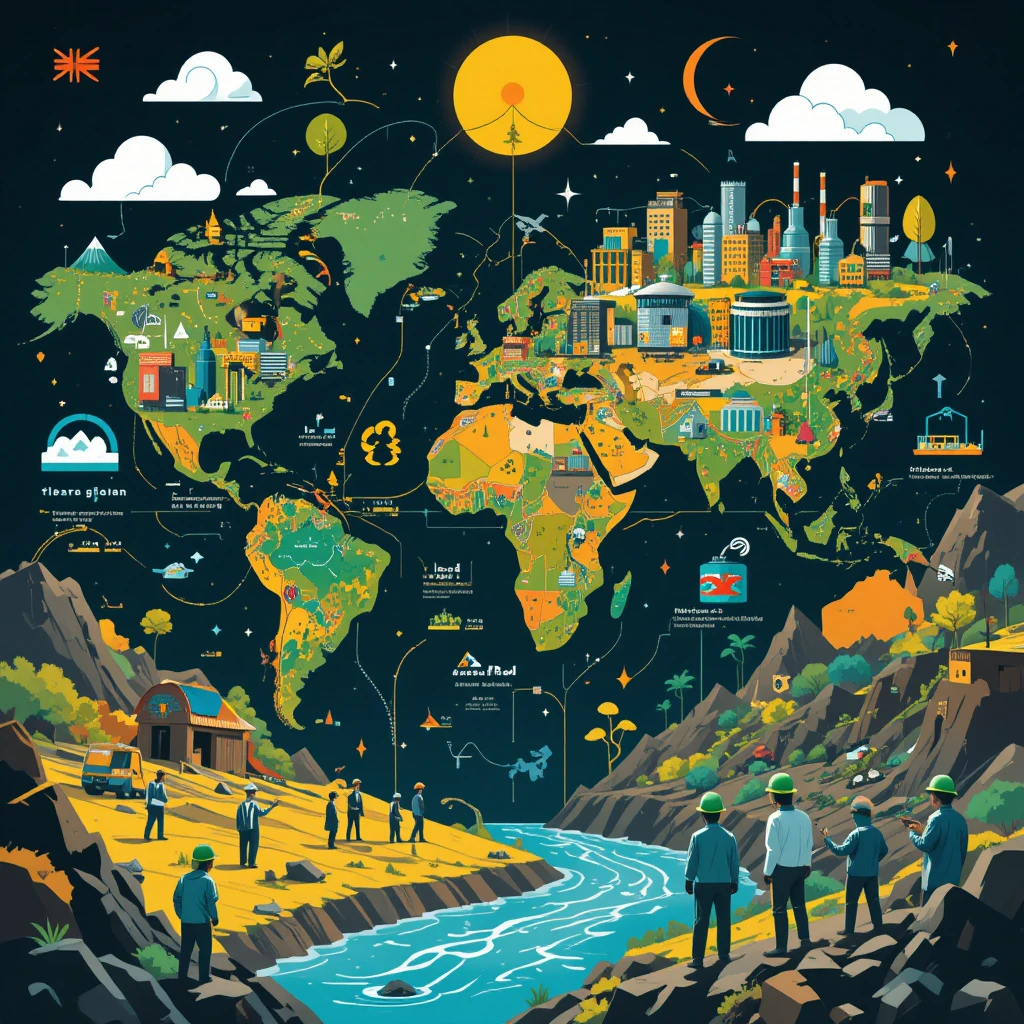China’s unparalleled control over rare earth metals, solar panels, batteries, and critical minerals has transformed it into a cornerstone of the global economy, wielding immense influence over economic, technological, and geopolitical landscapes. This comprehensive analysis details the scope of China’s dominance, the mechanisms behind its rise, the potential for global control, and the challenges it faces. By examining the interplay of resources, policies, and international dynamics, this article explores how China’s grip on these critical sectors could reshape the world order.

Table of Contents
Items Under China’s Dominance
China’s dominance spans a vast array of materials and technologies essential for modern industries, renewable energy, electronics, and defense. Below is an exhaustive list of the key items under its control, reflecting its strategic hold as of 2025:

1. Rare Earth Elements (REEs)
Rare earth elements, a group of 17 chemically similar elements, are indispensable for high-tech applications. China’s control over their supply chain is staggering:
- Key Elements:
- Neodymium, Praseodymium, Dysprosium, Terbium: These are critical for high-performance neodymium-iron-boron (NdFeB) magnets used in electric vehicle (EV) motors, wind turbine generators, and defense systems such as missile guidance, radar, and satellite communications.
- Lanthanum, Cerium: Essential for nickel-metal hydride batteries in hybrid vehicles, catalytic converters in automobiles, and precision optical lenses.
- Yttrium, Europium, Samarium, Lutetium: Vital for phosphors in LED displays, medical imaging (e.g., PET scanners), and laser technologies.
- Market Share:
- Mining: ~60% of global production, with major operations in Inner Mongolia’s Bayan Obo mine, the world’s largest REE deposit.
- Refining: ~85-90% of global processing capacity, making China the de facto hub for turning raw ores into usable materials.
- Significance: REEs are non-substitutable in many applications, and their scarcity outside China amplifies its leverage.
2. Solar Panels
China’s dominance in solar photovoltaic (PV) technology underpins its role in the global energy transition:
- Polysilicon and Silicon:
- Produces ~80% of the world’s polysilicon, the primary material for solar cells.
- Controls silicon wafer production, a critical step in PV manufacturing.
- Supply Chain:
- Over 70% of global solar panel production, from raw material processing to final assembly.
- Major firms like JinkoSolar, LONGi, and Trina Solar dominate the market.
- Impact: China’s cost advantages and scale make it the backbone of global solar deployment, critical for meeting climate goals.
3. Batteries and Battery Materials
The rise of EVs and renewable energy storage has made lithium-ion batteries a cornerstone of modern technology, and China controls key components:
- Lithium:
- Refines ~60% of global lithium, used in battery cathodes.
- Major operations in China’s Jiangxi province and investments in South American “Lithium Triangle” (Chile, Argentina, Bolivia).
- Cobalt:
- Controls ~70% of refined cobalt, primarily sourced from the Democratic Republic of Congo (DRC), where Chinese firms own or finance major mines.
- Graphite:
- Produces ~99% of battery-grade natural and synthetic graphite, and 100% of the graphite anode supply chain.
- Nickel:
- Leading producer of high-purity nickel for nickel-cobalt-manganese (NCM) batteries, used in long-range EVs.
- Battery Manufacturing:
- Hosts ~69% of planned lithium-ion battery mega-factories by 2029, led by companies like CATL and BYD.
- Produces over 70% of global EV batteries.
- Significance: China’s control over battery materials and manufacturing makes it indispensable for the EV revolution and grid-scale energy storage.
4. Other Critical Minerals
Beyond REEs and battery materials, China dominates several minerals vital for high-tech and defense applications:
- Gallium and Germanium:
- ~90% of global supply, used in semiconductors, solar cells, and infrared optics for night-vision and satellite systems.
- Antimony:
- ~90% of global production, critical for flame retardants, military ammunition, and night-vision goggles.
- Tungsten:
- ~80% of global supply, used in cutting tools, aerospace alloys, and semiconductor manufacturing.
- Magnesium:
- ~90% of global production, essential for lightweight alloys in automotive and aerospace industries.
- Significance: These minerals are often produced as byproducts of other mining operations, and China’s integrated processing capabilities give it unmatched control.
5. Renewable Energy Technologies
China’s leadership extends to renewable energy systems beyond solar:
- Wind Turbines:
- Produces the majority of rare earth magnets for turbine generators.
- In 2021, built more offshore wind capacity than the rest of the world combined over the previous five years.
- Companies like Goldwind and MingYang lead global markets.
- Green Hydrogen and Geothermal:
- Significant investments in electrolyzer production for green hydrogen and geothermal technology R&D.
- Impact: China’s dominance in wind and emerging clean energy technologies positions it as a leader in the global shift to renewables.
6. High-Tech Manufacturing
China’s control over advanced manufacturing components amplifies its influence:
- Permanent Magnets (NdFeB):
- ~87% of global production, used in EVs, wind turbines, robotics, and consumer electronics.
- Dominance stems from expertise in REE processing and cost advantages.
- Semiconductors:
- Supplies critical inputs like gallium and germanium, impacting global chip production.
- While not yet a leader in advanced chip fabrication, China’s control over raw materials affects the broader semiconductor ecosystem.
- Significance: These components are choke points in global supply chains, giving China leverage over multiple industries.
7. Battery Chemicals and Components
China’s dominance in battery production extends to specialized chemicals and components:
- Electrolyte Solutions:
- ~80% of global supply, critical for battery performance and longevity.
- Separators:
- ~60% of global production, used to prevent short-circuiting in batteries.
- Impact: Control over these niche but essential components reinforces China’s hold on the battery supply chain.
How China Achieved Dominance
China’s rise to dominance is a story of foresight, strategic policy, and global maneuvering, built over decades. The following factors explain its success:

1. Long-Term Industrial Policy
- Historical Context: In the 1980s, Deng Xiaoping famously likened rare earths to the Middle East’s oil, recognizing their strategic value. China began prioritizing REEs and critical minerals as national assets.
- Policy Tools:
- Subsidies and tax rebates lowered production costs, enabling Chinese firms to undercut global competitors.
- Export quotas and restrictions, notably in the 1990s and 2000s, consolidated China’s market share by limiting foreign access.
- By the early 2000s, China’s low-cost production had driven out competitors, such as the U.S.’s Mountain Pass mine, which shuttered in 2002.
- Environmental Trade-Offs: China’s willingness to tolerate the environmental costs of mining and refining—highly toxic processes—gave it a cost advantage over Western nations with stricter regulations.
2. Supply Chain Integration
- Vertical Control: China dominates the entire value chain, from mining to refining to manufacturing. For example, even ores mined in Australia or Africa are often shipped to China for processing due to its advanced facilities and expertise.
- Global Reach: Chinese firms have secured stakes in foreign mines, such as cobalt and lithium operations in the DRC and Zimbabwe, ensuring raw material access.
- Infrastructure Investments: Through the Belt and Road Initiative, China has built railways, ports, and processing plants in resource-rich regions, locking in supply chains.
3. Geopolitical Leverage
- Export Controls: China has repeatedly used its control over critical materials as a diplomatic weapon:
- In 2010, it halted rare earth exports to Japan during a territorial dispute over the Senkaku Islands, causing global price spikes.
- In 2024 and 2025, China imposed restrictions on samarium, gallium, germanium, and antimony in response to U.S. technology sanctions, disrupting Western supply chains.
- Strategic Messaging: These actions signal China’s readiness to use its resource dominance to counter political or economic pressures, creating a chilling effect on adversaries.
4. Research and Development (R&D)
- Expertise Development: Over 30 years, China has built unmatched expertise in REE processing, magnet production, and battery chemistry through sustained R&D investment.
- State Support: Universities and state-owned enterprises collaborate closely, ensuring innovations are rapidly commercialized.
- Global Lead: China’s technical know-how makes it difficult for competitors to replicate its processes, even with access to raw materials.
5. Clean Energy Leadership
- Early Investment: Since the 2000s, China has prioritized renewable energy as a strategic sector, offering subsidies, low-cost loans, and regulatory support to solar, wind, and EV industries.
- Scale Advantage: Massive domestic demand and production capacity have driven down costs, making Chinese firms globally competitive.
- Global Exports: In 2024, China accounted for 47% of clean tech exports to the Global South, cementing its role as a supplier of choice.
6. Economic Statecraft
- Global South Strategy: China’s investments in Africa, Latin America, and Southeast Asia secure resources while building diplomatic ties. For example, loans for infrastructure in the DRC ensure cobalt access.
- Market Flooding: By periodically flooding markets with cheap materials, China has undermined competitors, as seen in the collapse of non-Chinese REE producers in the 1990s.
How China Could Control the World
China’s dominance in these critical sectors positions it to exert significant global influence through economic, technological, and geopolitical mechanisms. Below is a detailed exploration of how this control could manifest:

1. Economic Leverage
China’s ability to manipulate supply and prices gives it unparalleled economic power:
- Price Manipulation:
- By controlling supply, China can flood markets with cheap materials to bankrupt competitors or restrict supply to drive up prices. For example, in the early 2000s, low-cost REE exports crippled Western producers, while 2010 export quotas caused price surges of up to 500% for some elements.
- In 2025, China’s restrictions on gallium and germanium led to price spikes, impacting semiconductor and solar industries.
- Dependency Risks:
- Western industries, including automakers (e.g., Tesla, Volkswagen), tech giants (e.g., Apple, Samsung), and renewable energy firms, rely heavily on Chinese materials. A supply disruption could halt production, as seen in 2024 when graphite restrictions affected EV battery output.
- Small and medium-sized enterprises, unable to absorb price volatility, are particularly vulnerable.
- Export Revenue:
- China’s clean tech exports—EVs, batteries, solar panels—are projected to reach $340 billion by 2035, rivaling the oil revenues of Saudi Arabia or the UAE.
- In 2024, China’s EV exports alone grew by 30%, capturing markets in Europe, Southeast Asia, and Africa.
- Global Trade Influence:
- China’s dominance allows it to set industry standards, such as battery specifications or solar panel designs, forcing global firms to align with its frameworks.
- By offering low-cost clean tech to developing nations, China gains market share and economic influence, reducing reliance on Western suppliers.
2. Technological Supremacy
Control over critical materials gives China a stranglehold on technological innovation:
- Innovation Bottlenecks:
- Rare earths and semiconductors are foundational to emerging technologies like artificial intelligence (AI), 5G networks, quantum computing, and autonomous vehicles. China’s control over gallium, germanium, and REEs limits other nations’ ability to develop these fields independently.
- For example, restrictions on samarium in 2025 disrupted U.S. efforts to develop advanced radar systems.
- Clean Energy Gatekeeper:
- The global transition to renewable energy relies on solar panels, wind turbines, and EV batteries, all dominated by China. A supply bottleneck could delay climate goals, as seen in 2024 when cobalt shortages slowed EV production in Europe.
- China’s control over battery chemicals (e.g., electrolytes) further tightens its grip, as these are difficult to source elsewhere.
- Defense Vulnerabilities:
- The U.S., NATO, and other allies depend on Chinese rare earths for military systems, including F-35 jets, drones, and laser-guided munitions. A prolonged embargo could compromise defense readiness.
- Antimony, critical for night-vision and ammunition, is another choke point, with 2025 export controls raising concerns among Western militaries.
- Standard Setting:
- By dominating production, China influences technical standards for batteries, magnets, and solar cells, locking in its technological frameworks globally.
3. Geopolitical Influence
China’s resource dominance translates into diplomatic and strategic power:
- Supply Chain Weaponization:
- Export bans are a proven tool for geopolitical leverage. The 2010 Japan embargo and 2025 restrictions on the U.S. demonstrate China’s willingness to use resources as a cudgel.
- These actions deter adversaries from imposing sanctions or challenging China on issues like Taiwan, Hong Kong, or human rights.
- Global South Alliances:
- In 2024, 47% of China’s clean tech exports went to Africa, Southeast Asia, and Latin America, fostering economic dependencies.
- For example, Chinese solar panels power much of sub-Saharan Africa’s electrification, while EV exports dominate Southeast Asian markets.
- These ties counterbalance Western influence, creating a bloc of nations aligned with China’s interests.
- Resource Control:
- Investments in African mines (e.g., DRC cobalt, Angola lithium) and infrastructure (e.g., railways, ports) secure long-term resource access while building diplomatic loyalty.
- China’s “debt-trap diplomacy” in countries like Zambia ensures resource concessions in exchange for loans.
- Soft Power:
- By positioning itself as a leader in clean energy, China gains moral authority in global climate talks, contrasting with Western delays in decarbonization.
- Its ability to supply affordable green tech enhances its image as a partner to developing nations.
4. Challenging Western Hegemony
China’s resource dominance offers a counterweight to Western financial and military power:
- Financial System Rival:
- While the U.S. controls global finance through the dollar and SWIFT, China’s grip on physical resources creates an alternative power base.
- By denominating resource trade in yuan or bartering clean tech for minerals, China could weaken dollar dominance over time.
- Decoupling Resistance:
- Western efforts to diversify supply chains—through initiatives like the U.S.’s CHIPS Act or the EU’s Critical Raw Materials Act—face significant hurdles:
- High costs: Building new mines and refineries requires billions and decades.
- Technical gaps: Western nations lack China’s processing expertise.
- Resource scarcity: Few viable deposits exist outside China’s control.
- These challenges give China a window to entrench its position, potentially lasting until 2040 or beyond.
- Western efforts to diversify supply chains—through initiatives like the U.S.’s CHIPS Act or the EU’s Critical Raw Materials Act—face significant hurdles:
- Strategic Autonomy:
- China’s self-sufficiency in critical materials reduces its vulnerability to Western sanctions, unlike Russia’s reliance on oil exports.
- By securing African and South American resources, China insulates itself from global supply shocks.
5. Economic Coercion and Market Control
China’s dominance enables it to shape global markets in its favor:
- Monopoly Power:
- In sectors like graphite and REEs, China’s near-monopoly allows it to dictate terms to buyers, forcing concessions on pricing or technology transfers.
- For example, Western firms seeking graphite anodes must often partner with Chinese suppliers, sharing intellectual property.
- Supply Shock Threats:
- The mere threat of export restrictions can compel compliance. In 2024, rumors of lithium curbs prompted European automakers to negotiate directly with Chinese suppliers.
- Global South Market Capture:
- By offering affordable EVs and solar panels, China displaces Western competitors in emerging markets, creating long-term dependencies.
- In Africa, Chinese firms like BYD and JA Solar dominate, sidelining European and U.S. brands.
Limits to China’s Dominance
While China’s control is formidable, it faces constraints that could temper its global influence:
1. Global Diversification Efforts
- Western Initiatives:
- The U.S. has revived the Mountain Pass mine and invested $1.2 billion in rare earth processing since 2022.
- Australia’s Lynas operates a refining plant in Malaysia, supplying ~10% of global REEs outside China.
- Canada’s Saskatchewan Research Council and Neo Performance Materials are scaling up processing capabilities.
- Multilateral Cooperation:
- The Quad (U.S., Japan, India, Australia) and G7 have launched critical mineral alliances to diversify supply chains.
- The EU’s 2024 Critical Raw Materials Act aims to source 40% of key minerals domestically or from allies by 2030.
- Alternative Sources:
- New deposits in Greenland, Canada, and Brazil are under exploration, though commercial production is years away.
- Recycling initiatives in Japan and Europe could reduce demand for virgin materials.

2. Economic Vulnerabilities
- Export Dependency:
- China’s rare earth and clean tech industries rely on global markets. Overusing export bans risks accelerating decoupling, costing China revenue.
- For example, 2025 gallium restrictions prompted South Korea to invest in domestic production, reducing Chinese market share.
- Economic Slowdown:
- China’s 2025 economic challenges, including a property sector slump and high debt, may limit its ability to subsidize industries or absorb losses.
- Budget constraints could force prioritization of domestic needs over global ambitions.
- Overcapacity Risks:
- China’s massive production capacity could lead to oversupply if global demand weakens, as seen in 2023 when solar panel prices crashed due to excess inventory.
3. Environmental and Social Pressures
- Domestic Backlash:
- Mining and refining pollution in China, particularly in Inner Mongolia, has sparked local protests and calls for stricter regulations.
- Compliance with environmental standards could raise costs, eroding China’s competitive edge.
- Global Scrutiny:
- International pressure to address mining’s environmental impact, including water contamination and carbon emissions, is growing.
- Western buyers increasingly demand “green” supply chains, which China struggles to meet.
- African Resistance:
- Labor exploitation and environmental degradation in African mines, such as DRC cobalt operations, have fueled strikes and local opposition.
- Political instability in resource-rich countries could disrupt China’s supply chains.
4. Technological and Market Shifts
- Rare Earth Alternatives:
- Automakers like GM, Toyota, and BMW are developing EV motors with reduced or no rare earths, using iron-based magnets or alternative designs.
- While not yet scalable, these innovations could reduce demand by 2035.
- Recycling Advances:
- Japan and the EU are investing in REE recycling from electronics and batteries, potentially meeting 10-15% of demand by 2030.
- Urban mining—extracting minerals from waste—could further weaken China’s grip.
- Substitution:
- For some applications, non-rare earth materials (e.g., gallium-free semiconductors) are under development, though performance gaps remain.
- Market Diversification:
- South Korea and Vietnam are emerging as battery and solar manufacturing hubs, supported by U.S. and EU investments.
5. Geopolitical Backlash
- Western Unity:
- U.S.-China tensions, including 2025 trade restrictions, have galvanized Western efforts to reduce dependency.
- NATO’s 2024 strategic minerals framework prioritizes securing non-Chinese supplies for defense.
- Global South Pushback:
- Some African nations, wary of Chinese debt, are seeking Western or Indian partnerships to diversify resource deals.
- For example, Zambia’s 2024 mining reforms aim to reduce Chinese influence over copper and cobalt.
- Sanction Risks:
- Escalating tensions over Taiwan or the South China Sea could prompt Western sanctions, disrupting China’s access to global markets.
Case Studies: China’s Influence in Action
To illustrate China’s dominance, consider these real-world examples:
1. The 2010 Japan Rare Earth Crisis
- Context: During a territorial dispute over the Senkaku Islands, China halted rare earth exports to Japan, a major consumer for electronics and automotive industries.
- Impact:
- Prices for neodymium and dysprosium surged by 400-500%, disrupting Japan’s supply chains.
- Japanese firms like Toyota and Hitachi faced production delays, costing billions.
- Outcome:
- Japan accelerated REE recycling and diversification, investing in Australian mines and domestic R&D.
- The crisis highlighted China’s willingness to use resources as a geopolitical weapon, prompting global alarm.
2. 2025 Gallium and Germanium Restrictions
- Context: In response to U.S. semiconductor export controls, China imposed export bans on gallium and germanium in early 2025.
- Impact:
- Global semiconductor prices rose by 20%, affecting chipmakers like Intel and TSMC.
- Solar cell production in Europe and the U.S. slowed, delaying renewable energy projects.
- Outcome:
- The U.S. and EU fast-tracked investments in alternative sources, such as germanium recycling in Germany and gallium production in Canada.
- The bans underscored China’s ability to disrupt high-tech industries at will.

3. Africa’s Cobalt Dependency
- Context: Chinese firms control over 60% of cobalt mining in the DRC, the world’s largest supplier.
- Impact:
- China secures stable cobalt supplies for its battery industry, while Western firms face shortages and price volatility.
- Local communities in the DRC face environmental degradation and labor abuses, sparking protests.
- Outcome:
- Western automakers, including Ford and Volkswagen, have sought direct deals with DRC mines to bypass Chinese intermediaries.
- China’s influence in the DRC has strengthened its diplomatic ties, countering U.S. and EU presence.
Conclusion
China’s dominance in rare earth metals, solar panels, batteries, and critical minerals positions it as a global superpower, capable of steering the world’s economic, technological, and geopolitical trajectory. By controlling the supply chains for clean energy, electronics, and defense, China wields economic leverage to manipulate markets, technological control to shape innovation, and geopolitical clout to build alliances and deter adversaries. Its clean tech exports, projected to reach $340 billion by 2035, rival the economic might of oil-producing nations, while its resource monopoly challenges Western financial dominance.
However, China’s power is not unassailable. Global diversification efforts, economic vulnerabilities, environmental pressures, and technological innovations pose challenges. The U.S., EU, and allies are investing heavily in alternative sources, recycling, and rare earth-free technologies, though these efforts will take years to mature. Meanwhile, China’s aggressive use of export bans risks alienating markets and accelerating decoupling, potentially undermining its long-term dominance.
The extent of China’s global control depends on its strategic choices. If it balances supply chain leverage with economic pragmatism, it could maintain its edge for decades. But overplaying its hand—through excessive restrictions or geopolitical brinkmanship—could galvanize a global push for self-sufficiency, reshaping the resource landscape. For now, China’s grip, as envisioned by Deng Xiaoping, remains a defining force, with profound implications for the 21st-century world order.
Recommendations for Countering China’s Dominance
To mitigate China’s influence and build resilience, nations should adopt a multi-pronged strategy:
- Develop Domestic and Allied Supply Chains:
- Subsidize mining and refining in stable jurisdictions, such as the U.S., Canada, and Australia.
- Support recycling programs to recover REEs and battery materials from waste.
- Invest in training to rebuild technical expertise lost to China’s dominance.
- Foster International Cooperation:
- Strengthen alliances like the Quad, G7, and Mineral Security Partnership to pool resources and develop alternative sources in Africa, Latin America, and Greenland.
- Negotiate trade agreements to secure access to critical minerals from friendly nations.
- Drive Technological Innovation:
- Fund R&D for rare earth-free magnets, alternative battery chemistries (e.g., sodium-ion), and gallium-free semiconductors.
- Accelerate urban mining and closed-loop recycling to reduce reliance on virgin materials.
- Support startups developing substitution technologies, such as iron-based magnets or organic solar cells.
- Build Strategic Reserves:
- Stockpile critical minerals like REEs, cobalt, and lithium to buffer against supply shocks.
- Establish public-private partnerships to manage reserves efficiently.
- Promote Sustainable Practices:
- Enforce environmental and labor standards in mining to level the playing field with China’s lax regulations.
- Incentivize “green” supply chains to appeal to consumers and investors.
- Counter Geopolitical Influence:
- Offer developing nations alternative clean tech and infrastructure deals to reduce China’s sway.
- Support governance reforms in resource-rich countries to prevent debt-trap diplomacy.
By pursuing these strategies, the global community can reduce its vulnerability to China’s dominance, fostering a more balanced and sustainable economic order. The path forward requires urgency, collaboration, and innovation to ensure that no single nation holds the keys to the world’s technological and environmental future.




